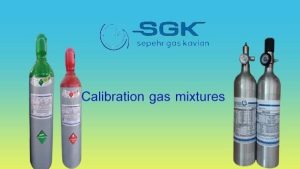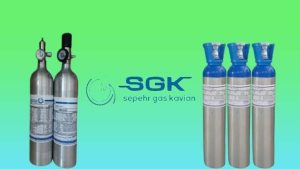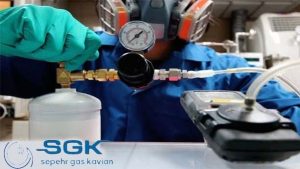Calibration gas mixtures
Calibration gas mixtures are mixtures of gases that are used to calibrate analytical instruments. These instruments are used to measure the concentration of gases in the air or other gases. These gases are used to ensure that the instruments are accurate.
These mixtures are provided by Sepehr Gas Kavian Company. The precise compositions and concentrations of the calibration gas mixtures can be adjusted and determined depending on the type and application of the required equipment.
These gases are typically composed of two or more gases. The gases in the mixture are typically chosen to be representative of the gases that the instrument is used to measure. For example, if an instrument is used to measure the concentration of carbon monoxide in the air, the calibration gas mixture might contain carbon monoxide and nitrogen.

Calibration gas mixtures are available in a variety of concentrations. The concentration of the gases in the mixture is typically chosen to be the same as the concentration of the gases that the instrument is used to measure. For example, if an instrument is used to measure the concentration of carbon monoxide in the air at a concentration of 100 parts per million (ppm), the calibration gas mixture might contain carbon monoxide at a concentration of 100 ppm.
Calibration gas mixtures are typically sold in cylinders. The cylinders are filled with the gas mixture at a high pressure. The cylinders are equipped with valves that allow the gas mixture to be released into the instrument.
These gases are an important part of ensuring that analytical instruments are accurate. By using calibration gas mixtures, you can be sure that your instrument is measuring the concentration of gases correctly.
Resources
When choosing a source of these gases, it is important to consider the following factors:
The type of gases you need: The first step is to identify the gases that you need to calibrate your instrument. Once you know the gases you need, you can start to narrow down your options.
The concentration of the gases: You also need to consider the concentration of the gases in the mixture. The concentration of the gases in the mixture should be the same as the concentration of the gases that your instrument is used to measure.
The purity of the gases: The purity of the gases in the mixture is also important. The purity of the gases in the mixture should be high enough to meet the requirements of your instrument.
The price of the mixtures: The price of the mixtures is also an important factor to consider. You need to find a source that offers calibration gas mixtures at a price that you can afford.

Application
These gases are used in a wide variety of applications, including:
Environmental monitoring: Calibration gas mixtures are used to calibrate instruments that are used to measure the concentration of gases in the environment. This includes instruments that are used to measure the concentration of pollutants in the air, water, and soil.
Industrial process control: These gases are used to calibrate instruments that are used to monitor industrial processes. This includes instruments that are used to measure the concentration of gases in industrial gases, liquids, and solids.
Medical diagnostics: Calibration gas mixtures are used to calibrate instruments that are used to diagnose medical conditions. This includes instruments that are used to measure the concentration of gases in the blood, breath, and other bodily fluids.
Research and development: These gases are used to calibrate instruments that are used in research and development. This includes instruments that are used to measure the concentration of gases in new products and materials.
These gases are an essential part of ensuring that analytical instruments are accurate. By using calibration gas mixtures, you can be sure that your instrument is measuring the concentration of gases correctly.
Here are some of the benefits of using these gases in these applications:
Ensure accuracy: Calibration gas mixtures ensure that analytical instruments are accurate by providing a known concentration of gases to compare against.
Improve precision: Calibration gas mixtures improve the precision of analytical instruments by providing a consistent concentration of gases to measure against.
Increase confidence: These gases increase confidence in the results of analytical measurements by providing a known and consistent baseline.
Save time and money: These gases save time and money by eliminating the need to send samples to a laboratory for analysis.

Types of calibration gases
There are two main types of calibration gases:
Zero-calibration gas: A zero-calibration gas is a mixture that contains no flammable gases. Zero-calibration gases are used when gas detection or gas analyzers are calibrated with an analyte gas structure that the detector will not respond to.
Span calibration gas: A span calibration gas is more advanced, as it’s a detectable gas concentration that’s precisely composed and used for a gas detector or analyzer.
Here are some of the most common types of calibration gases:
Hydrogen: Hydrogen is a flammable gas that is used in a variety of applications, including fuel cells, welding, and rocket propulsion.
Oxygen: Oxygen is an essential gas for life and is used in a variety of applications, including breathing, combustion, and welding.
Nitrogen: Nitrogen is an inert gas that is used in a variety of applications, including packaging, insulation, and welding.
Carbon monoxide: Carbon monoxide is a poisonous gas that is produced by incomplete combustion. It is used in a variety of applications, including medical diagnostics and industrial process control.
Hydrocarbons: Hydrocarbons are a group of organic compounds that contain hydrogen and carbon. They are used in a variety of applications, including fuels, plastics, and solvents.
Calibration gases are typically sold in cylinders. The cylinders are filled with the gas mixture at a high pressure. The cylinders are equipped with valves that allow the gas mixture to be released into the instrument.





